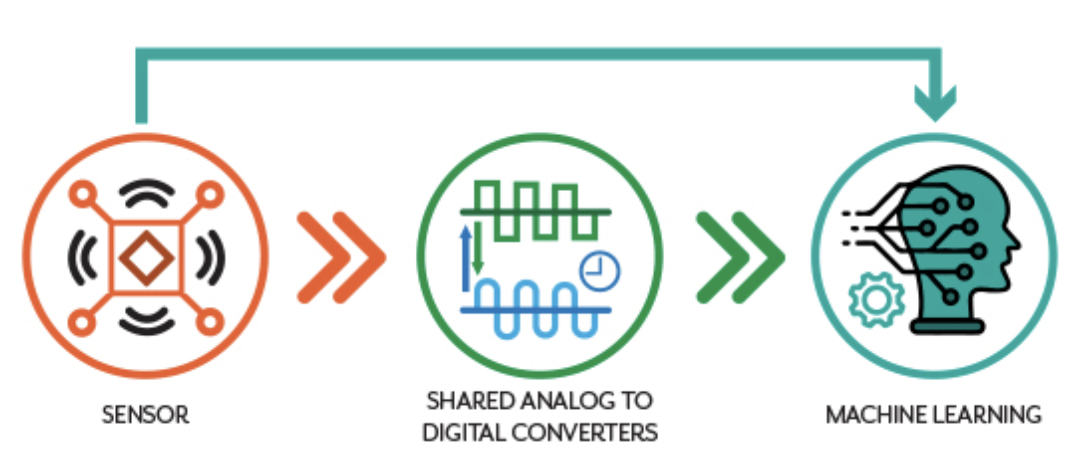Edge AI Sensors Plot Analog, Digital Routs

AI vendors are rolling out a steady stream of edge processing platforms spanning everything from multicore systems-on-chips to analog approaches that seek to imbue sensors with greater intelligence while reducing power consumption in always-on devices.
Along with lower latency, smart edge deployments require low-power AI processing via a variety of hardware and optimized software frameworks. A pair of approaches emerged this week, one silicon-based that leverages machine learning compilers, the other an analog, mixed signal scheme that embeds intelligence within internet of things (IoT) and other sensors.
The AI SoC unveiled Tuesday (Dec. 15) by Synaptics Inc. (NASDAQ: SYNA) and a partner is aimed at low-power industrial IoT and consumer devices running on batteries. The Katana platform combines energy efficient AI software with a low-power SoC, and is aimed at edge devices used for object recognition, inventory tracking and environmental sensing.
Synaptics, of San Jose, Calif., also announced an investment and partnership with Eta Compute Inc., a low-power edge inferencing specialist based in Westlake Village, Calif., which contributed its AI software to the new edge platform.
The combination of a multi-core processor and AI compiler is aimed at battery operated edge devices requiring software optimization techniques that are tightly coupled to silicon. Synaptics also said it is working with Eta Compute on development kits that include pre-trained machine learning models and reference designs. Together, they would also enable users to train models on internal data sets using Caffe, TensorFlow and the Open Neural Network Exchange machine learning format.
In conjunction with the edge AI partnership, Synaptics also led Eta’s latest funding round that reaped $12.5 million. The funds will be used to co-develop edge applications focused on low-power audio and machine vision deployments for industrial IoT and other sectors.
Eta recently released an edge AI platform consisting of a neural sensor processor and neural network compiler. The five-year-old startup said the partnership with Synaptics gives it a foundation for extending its AI platform to low-power edge applications like image and sensor processing.
Eta’s processor and AI sensor board technologies are based on the startup’s proprietary Continuous Voltage and Frequency Scaling technology used in embedded and machine learning applications. “This is accomplished by lowering the power supply voltage to levels at which most people would expect a transistor to be completely shut off,” explained Gopal Raghavan, Eta Compute’s co-founder.
Also this week, startup AIStorm unveiled an analog AI processor based on its charge domain processing technology designed to overcome noise and bandwidth limits. The charge domain approach, which performs monolithic signal processing, allows IoT sensors to directly process data without digitization and the resulting latency and power penalties.
IoT sensors produce analog outputs. Microcontrollers, digital signal processors and GPUs are often used to poll sensor data. “This means they digitize the input information, packetize it, send it to a digital AI system and then decide on every possible event,” said AIStorm CEO David Schie.
“If they poll too often, they are draining power [and] battery life. If they poll infrequently, they can miss an important event, for instance a security camera could miss an intruder.”
The startup’s platform uses electron charge gleaned natively from pixels, for example, then feeds that charge directly into its neural network to perform a multiply-accumulate function.
AIStorm claims its platform can multiply electrons from pixels or an interface directly to a membrane microphone. “This is what gives us the ability to do much lower power wake-up or what is called ‘always on’,” said Schie
Proponents of the technology note it overcomes limits in similar charge-coupled devices, for example, by dividing, routing and combining charge packets.
In AIStorm’s implementation, the result is touted as an AI-in-sensor that “skips the middle steps” to link devices to convolutional neural networks, allowing faster processing at the network edge with minimal power consumption, according to the company.
The analog and mixed-signal approach is incorporated in a proprietary media access controller designed to allow sensors to react to events and perform predictive analytics.
San Jose-based AIStorm also this week announced a $16 million Series B funding round. Investors include AsusTek (TPE: 2357) as the Taiwanese computer manufacturer is expanding into the IoT device market.
-Editor's note: This story has been updated, It also corrects an erroneous reference in a previous version to a media access controller.
Related
George Leopold has written about science and technology for more than 30 years, focusing on electronics and aerospace technology. He previously served as executive editor of Electronic Engineering Times. Leopold is the author of "Calculated Risk: The Supersonic Life and Times of Gus Grissom" (Purdue University Press, 2016).











